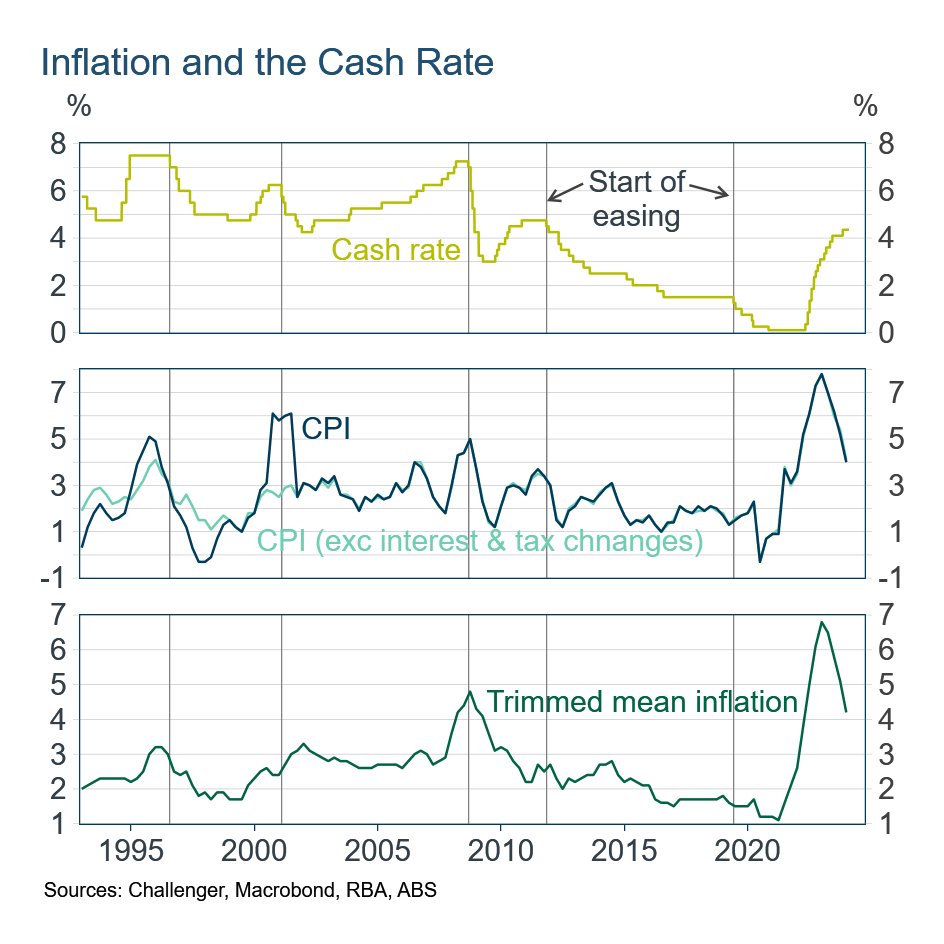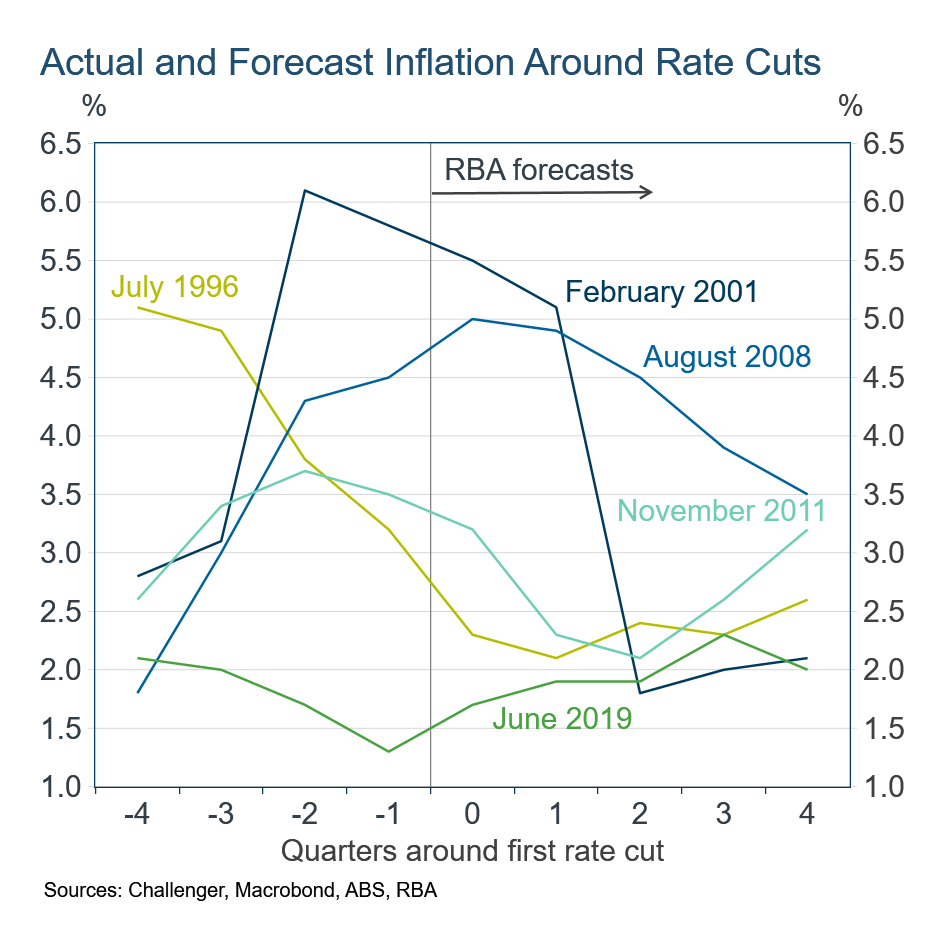Will the RBA wait until inflation is less than 3% to start cutting?
The RBA’s forecasts released last Tuesday have inflation falling sharply to 3.3% by mid this year but more slowly after that and not returning to the 2-3% target until the second half of 2025. Governor Bullock was asked at her press conference whether inflation would need to be in the target before the RBA would cut. She replied that
“If we’re getting there and we look to be on track to be sustainably in the band then we might be able to think about interest rate cuts, but we have to be confident”.
The market is pricing the first cut by August this year when, if the RBA is right, the latest inflation reading will be 3.3%. Would the RBA cut before inflation is in the 2–3% band?
There are limited past easing cycles to draw evidence from, and each cycle has different features. But there are examples of the RBA cutting before inflation was in the target range:
- At the beginning of the easing cycle in September 2008 CPI inflation and trimmed mean inflation were still around 5%. Subsequently the onset of the Global Financial Crisis saw interest rates cut sharply and inflation fall faster than expected.
- In November 2011 the RBA also began to ease when inflation was outside the target at 3.4%, although the RBA noted that this in part reflected weather effects and inflation was forecast to fall (and trimmed mean inflation was already 2.5%).


By contrast, the easy cycle that started in July 1996 did not commence until inflation was already back in the 2–3% band with the Governor noting “underlying inflation is consistent with the 2–3 per cent objective”. The easing cycles starting June 2019 and February 2001 occurred with inflation below and in the 2–3% band (abstracting from the new GST).
Overall, past RBA behaviour is consistent with Governor Bullock’s response that the RBA could start cutting rates with inflation above 3%, but it would have to be confident that inflation was headed to 2.5%.
If the RBA’s inflation forecasts are right, it is possible the RBA cuts in the third quarter this year as the market expects, but given the significant risks to services inflation from strong wages and more broadly from weak productivity and the fact that policy is currently not that restrictive, by no means are cuts this year locked in.
Details on RBA statements at the beginning of past easing cycles:
July 1996 – RBA press statement (31/07/1996) “decision reflects the Board's judgment that underlying inflation is consistent with the 2–3 per cent objective” “Last week's CPI figure showed a further reduction in underlying inflation, to 3.1 per cent in the year to the June quarter. That figure was held up by the relatively large increase in the September quarter a year ago. Over the first half of 1996, inflation was running at an annual rate of around 2½ per cent. Most other price indicators are showing lower rates; the Statistician's series of manufacturing prices, for example, has shown virtually no increase in domestically produced final goods prices over the past year. The Bank's forecasts suggest that both underlying and headline inflation will be in the 2–3 per cent range for some time.”
February 2001 – RBA press statement (07/02/2001) “Recent data show that consumer price inflation remains low, despite the lift in wholesale prices resulting from the decline in the exchange rate and the rise in raw materials and energy prices last year. While CPI inflation measured over the past four quarters still reflects the impact of the GST and the rise in petrol prices, underlying inflation net of those effects is estimated to be around 2 per cent, slightly lower than was the case in the middle of last year. Labour cost increases remain moderate; inflation expectations have fallen back after increasing last year; and the exchange rate has risen somewhat since late last year, though it remains quite low by historical standards. Even allowing for possible lagged effects of previous falls in the exchange rate on consumer prices in the year ahead, the Bank judges that the risk of exceeding the inflation target has declined materially, and expects CPI inflation to be within the target zone over the coming year.”
September 2008 – RBA press statement (03/09/2008) “Inflation in Australia has been high over the past year in an environment of limited spare capacity and earlier strong growth in demand. In these circumstances, the Board has been seeking to restrain demand in order to reduce inflation over time.” Inflation is likely to remain relatively high in the short term, with the CPI affected by the high global oil prices in mid-year and other increases in raw materials prices. But looking further ahead, the outlook for demand suggests that inflation in both CPI and underlying terms is likely to decline over time, provided wages growth remains contained. The Bank's forecast remains that inflation will fall below 3 per cent during 2010.”
November 2011 – RBA press statement (02/11/2011) “After underlying inflation started to pick up in the first half of the year, recent information suggests the subdued demand conditions and the high exchange rate have contained inflation more recently, notwithstanding continuing sizeable increases in utilities charges. CPI inflation on a year-ended basis remains above the target, due to the effects of weather events last summer, but is now starting to decline as production of key crops recovers. Moreover, with labour market conditions now softer, the likelihood of a significant acceleration in labour costs outside the resources and related sectors in the near term has lessened. Accordingly, the Bank's current judgement is that inflation is likely to be consistent with the 2–3 per cent target in 2012 and 2013, abstracting from the impact of the carbon pricing scheme.”
June 2019 – RBA press statement (05/06/2019) “provide greater confidence that inflation will be consistent with the medium-term target” and “The recent inflation outcomes have been lower than expected and suggest subdued inflationary pressures across much of the economy. Inflation is still however anticipated to pick up and will be boosted in the June quarter by increases in petrol prices. The central scenario remains for underlying inflation to be 1¾ per cent this year, 2 per cent in 2020 and a little higher after that.”
3 topics

